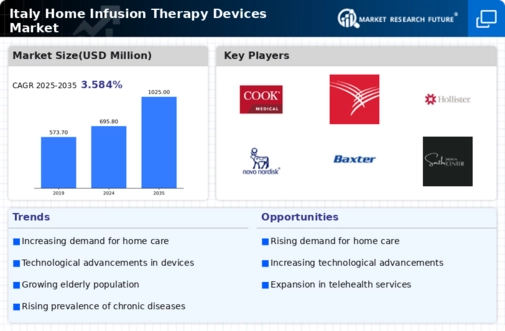Aging Population
Italy's demographic shift towards an aging population significantly influences the home infusion-therapy-devices market. With over 23% of the population aged 65 and older, there is a heightened need for healthcare services tailored to the elderly. This demographic often requires long-term infusion therapies for various health issues, including pain management and nutritional support. The preference for home care among older adults, driven by the desire for independence and comfort, further fuels the demand for infusion devices. As a result, manufacturers are likely to innovate and develop user-friendly devices that cater specifically to this age group. The home infusion-therapy-devices market is poised for growth as the elderly population continues to expand, necessitating more accessible and efficient healthcare solutions.
Supportive Healthcare Policies
Supportive healthcare policies in Italy are fostering the growth of the home infusion-therapy-devices market. The government is increasingly recognizing the importance of home care in alleviating pressure on hospitals and improving patient outcomes. Initiatives aimed at promoting home healthcare services are being implemented, which include reimbursement policies for home infusion therapies. These policies not only enhance accessibility for patients but also encourage healthcare providers to adopt home-based treatment options. As the regulatory environment becomes more favorable, the home infusion-therapy-devices market is likely to experience significant growth, driven by increased investment and innovation in home care solutions.
Cost-Effectiveness of Home Care
The economic advantages associated with home care are becoming increasingly apparent, thereby driving the home infusion-therapy-devices market. Home infusion therapies can reduce hospital stays and associated costs, which is particularly appealing to both patients and healthcare providers. Studies indicate that home-based treatments can save the healthcare system up to 30% compared to traditional hospital care. This cost-effectiveness is prompting healthcare policies to favor home care solutions, leading to increased investments in home infusion technologies. As patients and insurers recognize the financial benefits, the demand for home infusion-therapy-devices is likely to rise, encouraging further innovation and market expansion.
Rising Prevalence of Chronic Diseases
The increasing incidence of chronic diseases in Italy is a primary driver for the home infusion-therapy-devices market. Conditions such as diabetes, cancer, and cardiovascular diseases necessitate ongoing treatment, often requiring infusion therapies. According to recent health statistics, approximately 25% of the Italian population suffers from chronic illnesses, leading to a growing demand for home-based care solutions. This trend is likely to propel the adoption of infusion devices, as patients prefer receiving treatment in the comfort of their homes. Furthermore, the healthcare system is shifting towards more cost-effective solutions, making home infusion therapies an attractive option. The home infusion-therapy-devices market is expected to expand. This expansion is due to healthcare providers increasingly recognizing the benefits of these devices in managing chronic conditions effectively.
Technological Innovations in Infusion Devices
Technological advancements in infusion devices are transforming the home infusion-therapy-devices market. Innovations such as smart infusion pumps, which offer enhanced accuracy and monitoring capabilities, are becoming more prevalent. These devices often feature connectivity options that allow healthcare providers to monitor patient data remotely, improving treatment outcomes. The integration of mobile applications for patient management is also gaining traction, enabling users to track their therapy schedules and medication adherence. As technology continues to evolve, the home infusion-therapy-devices market is expected to benefit from increased efficiency and patient engagement, ultimately leading to higher adoption rates.





















Leave a Comment